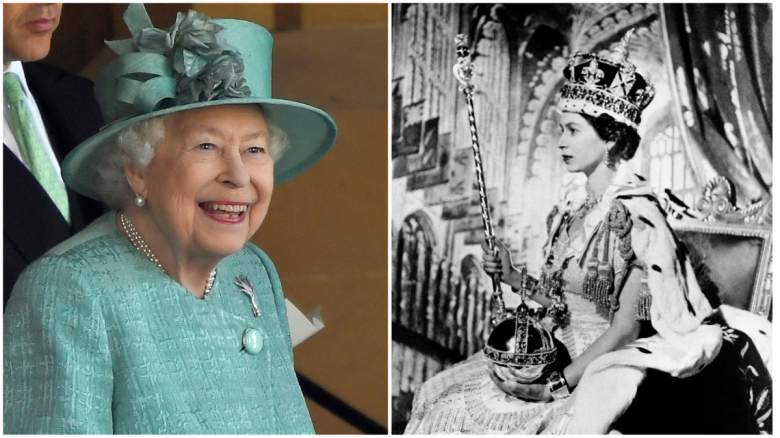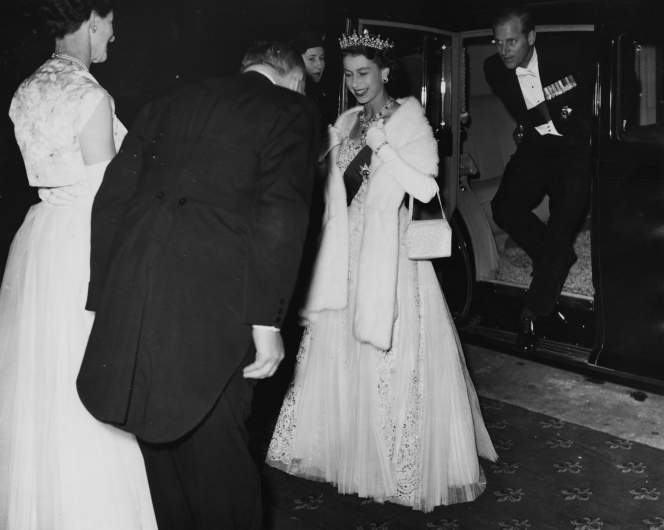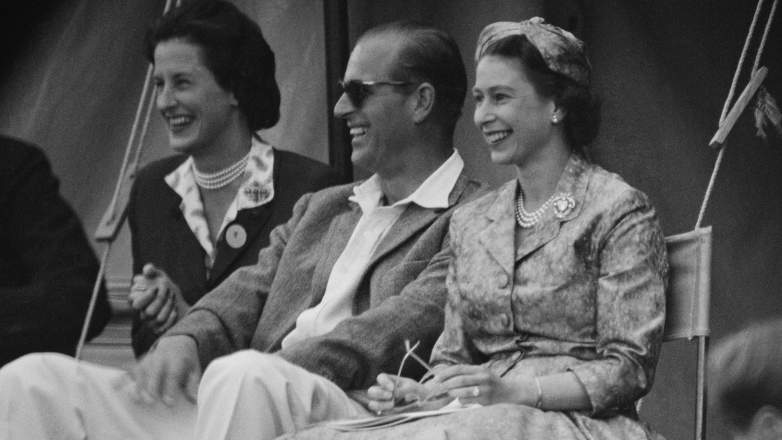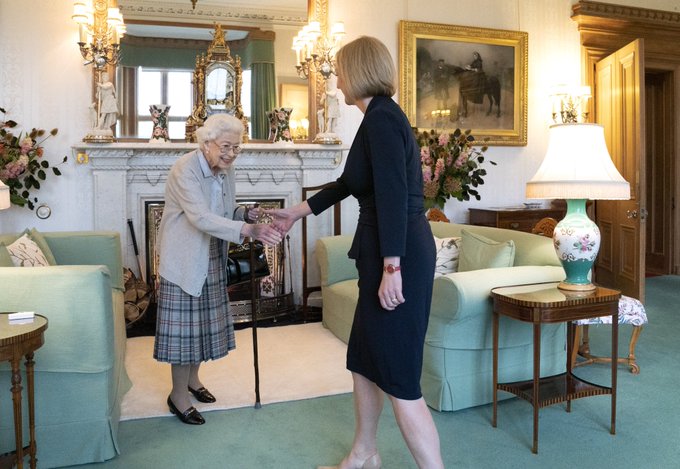
Getty Queen Elizabeth is dead at 96.
Queen Elizabeth II, the longest-reigning monarch in British history, who served her country as queen since 1952 and was a symbol of stability and unity, is dead at the age of 96.
The royal family announced the news on September 8, 2022, writing, “The Queen died peacefully at Balmoral this afternoon. The King and The Queen Consort will remain at Balmoral this evening and will return to London tomorrow.”
A vivid double rainbow appeared over Buckingham Palace, Windsor Castle and other British landmarks as crowds gathered in tribute to the Queen.

GettyA Buckingham Palace rainbow photo
Liz Truss, the new British prime minister, said, according to CNN: “She was the very spirit of Great Britain, and that spirit will endure.”
In a statement, the new King Charles said his mother’s death was “a moment of the greatest sadness for me and all members of my family.”
According to USA Today, Prince Charles became King immediately upon his mother’s death. She was the “41st monarch since William the Conqueror in 1066,” the newspaper reported.
The queen is one of the most unifying figures in British history. Her family rushed to her bedside at Balmoral Castle in the Scottish Highlands on September 8, 2022, as fears about her health escalated. The queen had struggled with mobility issues and was looking increasingly frail ever since the death of her husband, Prince Philip, who died at age 99 in April 2021. The official cause of Elizabeth’s death was not yet clear.
It was a steady decline and long goodbye of sorts, not a sudden death. The queen’s death plunged England into a period of mourning as tributes flowed for the monarch. Her heir, Charles, was at her bedside, along with the queen’s three other children, Princess Anne and Princes Andrew and Edward.
Royal biographer Robert Hardman told BBC: “She is unlike any other monarch in our history — she’s our longest-lived, longest-serving, longest-reigning monarch. She just stands for this constancy, this sense of permanence and stability.”
“Suddenly, at times like this, we all realise … how precious she is,” he added.
Elizabeth II became queen in 1952, but her coronation was in 1953, according to Biography.com.
Here’s what you need to know:
1. Buckingham Palace Announced That the Queen’s Doctors Were ‘Concerned for Her Majesty’s Health’

GettyIn 1954, the year this photo was taken of the recently crowned queen, Elizabeth II met Billy Graham.
Shortly before she died, Buckingham Palace released a statement on the queen’s health on September 8, 2022. “Following further evaluation this morning, The Queen’s doctors are concerned for Her Majesty’s health and have recommended she remain under medical supervision,” it read. “The Queen remains comfortable and at Balmoral.”
According to BBC, well-wishers were starting to gather outside Balmoral Castle. Former Prime Minister David Cameron tweeted, “I send my heartfelt thoughts and prayers to Her Majesty The Queen and the royal family at this worrying time.” He wrote that he was “deeply concerned.”
The queen’s death was known via code name as “London Bridge.”
2. Elizabeth II’s Coronation as Queen Came in 1953

GettyQueen Elizabeth II and Prince Philip, Duke of Edinburgh, watch a cricket match at Highclere Castle in 1958.
The queen served since her coronation in 1953, according to her palace biography.
According to her website, “In 1937, the 11-year-old Princess Elizabeth had watched her father, King George VI, crowned in the elaborate ceremony and 16 years later on 2 June 1953, her own official coronation was to take place.”
She never expected to be queen; that came after the abdication of her uncle.
“Queen Elizabeth II was born Princess Elizabeth Alexandra Mary on April 21, 1926, in London, to Prince Albert, Duke of York (later known as King George VI), and Elizabeth Bowes-Lyon,” Biography.com reported. She spent World War II with her family at Windsor Castle.
In 1940, at age 14, and with World War II raging throughout Europe, the young princess said in a radio broadcast, “That in the end, all will be well; for God will care for us and give us victory and peace,” Biography.com reported.
She married her husband, Philip, in 1947, and they had four children together, Charles, Anne, Edward and Andrew.
3. The Queen’s Children Journeyed to Balmoral to Her Bedside

GettyQueen Elizabeth II attends a performance at the Royal Academy of Dramatic Art in November 1964.
According to the BBC, all of the Queen’s children — Charles, Anne, Edward and Andrew — traveled to her bedside at Balmoral, as had Prince William.
Prince Harry also headed to Scotland, according to Daily Mail. However, his wife, Meghan, remained behind in London, according to Page Six. The Duke and Duchess of Sussex were in England and Germany this week for a series of events but had not yet seen the royal family.
According to Daily Mail, William, Edward and Andrew, and Edward’s wife, Sophie, flew to Scotland on a Royal Air Force jet to be at the queen’s bedside. William’s wife, Kate, remained behind with their children.
Former BBC royal correspondent Richard Sumner told BBC that the cautious wording of the statement suggested that “something serious is possibly going on.” The queen has had mobility issues for some time.
Speaking on BBC News, he says: “The whole policy of the palace has always been understatement, and I’ve always suspected that possibly there was more than a mobility problem concerned here.”
BBC wrote, “There is a degree of seriousness that we have not seen before, the very fact that the statement was issued when the palace is so reticent about making any commentary on the queen’s health.”
4. The Queen’s Last Public Appearance Was Appointing Liz Truss the New English Prime Minister

GettyQueen Elizabeth II pictured on Christmas Day 2018.
The Queen’s last public appearance came on September 6, 2022, when she met the new prime minister. “The queen received Liz Truss at Balmoral Castle today,” the royal family tweeted.
“Her Majesty asked her to form a new Administration. Ms. Truss accepted Her Majesty’s offer and was appointed Prime Minister and First Lord of the Treasury.”
Truss tweeted as the queen’s health decline was released, “The whole country will be deeply concerned by the news from Buckingham Palace this lunchtime. My thoughts — and the thoughts of people across our United Kingdom — are with Her Majesty The Queen and her family at this time.”
The royal family noted, “Ms. Truss is the 15th Prime Minister to serve during Her Majesty’s reign. The first was Winston Churchill in 1952.”
After the queen’s death, Truss said, according to CNN, “Britain is the great country it is today because of her. We are now a modern, thriving, dynamic nation. Through thick and thin, Queen Elizabeth II provided us with he stability and the strength that we needed.”
5. Queen Elizabeth II, Who Was Born in 1926, Is the Longest-Reigning Monarch in British History
According to her biography on the Royal Family’s website, Queen Elizabeth II “has ruled for longer than any other Monarch in British history, becoming a much loved and respected figure across the globe. Her extraordinary reign has seen her travel more widely than any other monarch, undertaking many historic overseas visits. Known for her sense of duty and her devotion to a life of service, she has been an important figurehead for the UK and the Commonwealth during times of enormous social change.”
The bio notes, “The Queen was born at 17 Bruton St on 21 April 1926 and christened on 29 May 1926 at Buckingham Palace #HM90facts.”
According to Biography.com, “Elizabeth’s long and mainly peaceful reign has been marked by vast changes in her people’s lives, in her country’s power, how Britain is viewed abroad and how the monarchy is regarded and portrayed.”
READ NEXT: The Death of Prince Philip
